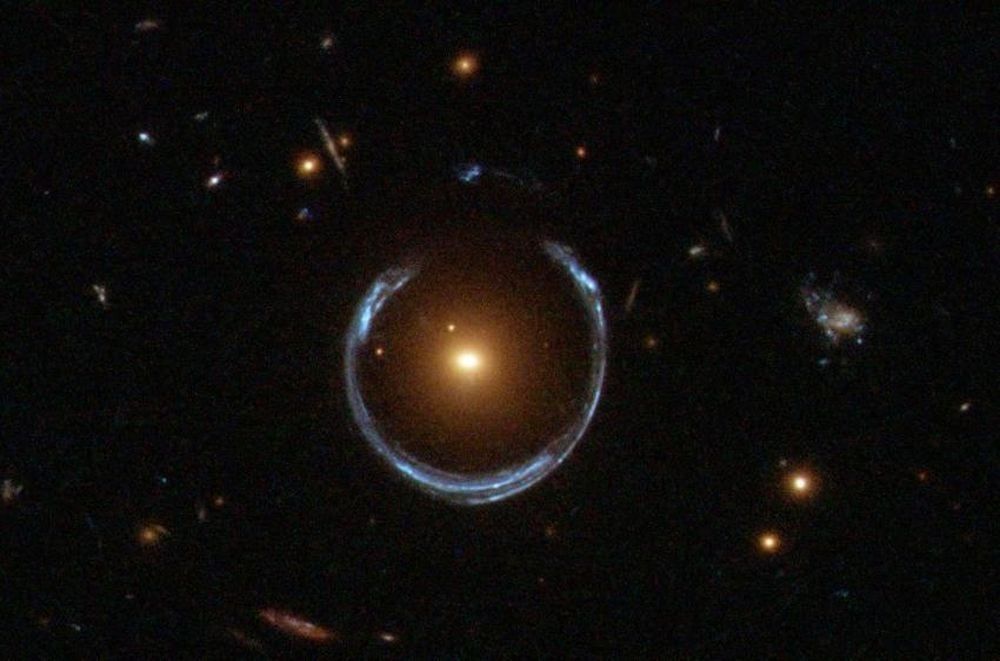In 1964, astronomers discovered the first black hole. It’s called Cygnus X-1 and the evidence for its existence was discovered by x-ray detectors on a sub-orbital sounding rocket. Cygnus X-1 is about 7,300 light-years away and has about 21 solar masses. Since then, astronomers have discovered increasingly more massive black holes, including supermassive black holes (SMBH) at the heart of large galaxies like ours.
Now astronomers have detected what could very well be the most massive black hole ever detected. The discovery is reported in the Monthly Notices of the Royal Astronomical Society. The research is titled “Unveiling a 36 billion solar mass black hole at the centre of the Cosmic Horseshoe gravitational lens,” and the lead author is PhD candidate Carlos Melo, of the Universidade Federal do Rio Grande do Sul (UFRGS) in Brazil.
It’s not quite axiomatic that the more massive a galaxy is, the more massive the black hole in its center. But we’re getting there. This ultra-massive object resides in the Cosmic Horseshoe, which is one of the most massive galaxies ever detected. The Cosmic Horseshoe is one of the only gravitational lenses with an almost complete Einstein ring rather than just the typical arcs that make up most Einstein rings.
“This is amongst the top 10 most massive black holes ever discovered, and quite possibly the most massive,” said Thomas Collett, a Professor and researcher at the University of Portsmouth.
Determining a black hole’s mass is no simple exercise. Headline writers are free to make simple declarations, but scientists are much more circumspect. They know that every claim of a black hole’s mass is accompanied by caveats concerning how it was measured. But in this case, they’re more certain.
At 36 billion solar masses, this ultra-massive black hole (UMBH) is definitely in the top ten most massive black holes ever detected. However, it could be the most massive. The problem is in how different black hole masses are measured.
“Most of the other black hole mass measurements are indirect and have quite large uncertainties, so we really don’t know for sure which is biggest,” Collett said in a press release. “However, we’ve got much more certainty about the mass of this black hole thanks to our new method.”
Stellar kinematics, the motion of stars near a black hole, is considered the most accurate way to determine a black hole’s mass. It’s what helped astronomers determine the mass of the Milky Way’s SMBH, Sagittarius A-star. The group of stars that orbits near Sgr A-star are called S stars. Their high velocities and their close proximity to the SMBH allowed astronomers to determine Sgr A-star’s mass: about 4.3 million solar masses.
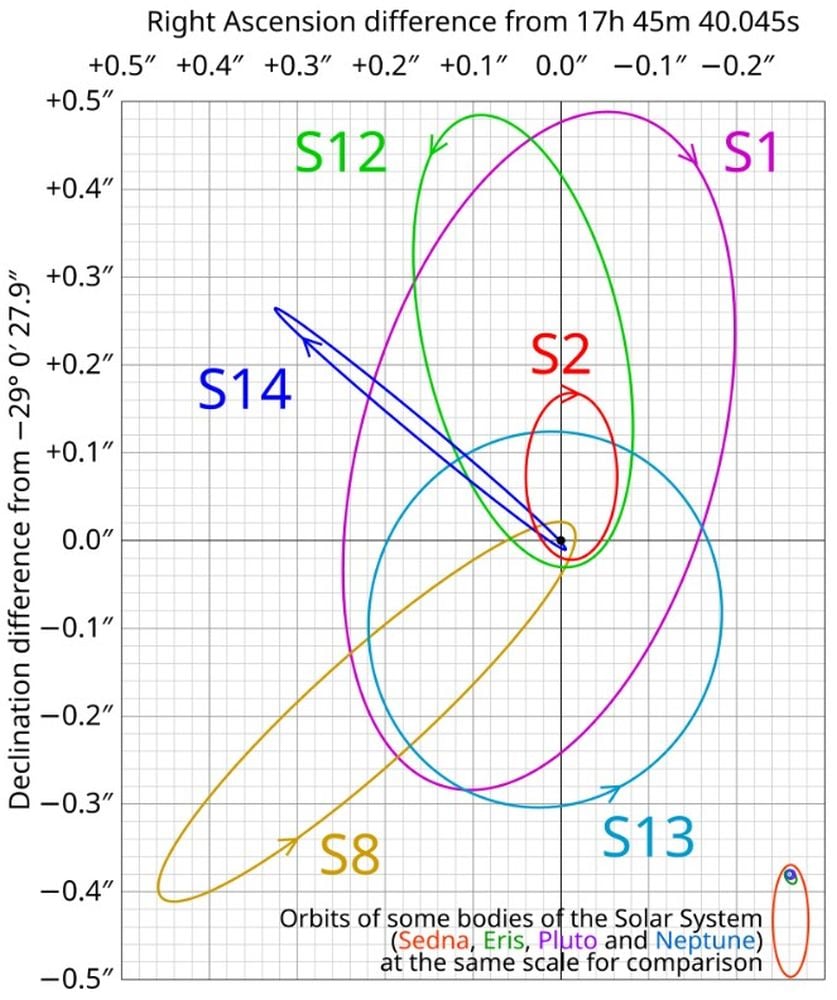 This schematic shows some of the S stars that helped astronomers understand the SMBH in the center of the Milky Way. Image Credit: By Cmglee – Own work by tracing the ellipses on Figure 7 of http://iopscience.iop.org/article/10.1086/430667/pdf (No numerical data was found), CC BY-SA 3.0, https://commons.wikimedia.org/w/index.php?curid=15252541
This schematic shows some of the S stars that helped astronomers understand the SMBH in the center of the Milky Way. Image Credit: By Cmglee – Own work by tracing the ellipses on Figure 7 of http://iopscience.iop.org/article/10.1086/430667/pdf (No numerical data was found), CC BY-SA 3.0, https://commons.wikimedia.org/w/index.php?curid=15252541
Stellar kinematics works great for nearby SMBHs like the one in our galaxy. But the further away an SMBH is, the more difficulties stellar kinematics faces. Distant galaxies are so small in the sky that tracking the orbits of individual stars is next to impossible. This is where gravitational lensing comes in.
When a massive foreground object lines up with a distant object from our point of view, the foreground object’s gravity amplifies light from the background object. It both alters the light’s path and affects the trajectories of the stars in the galaxy’s center.
“We detected the effect of the black hole in two ways – it is altering the path that light takes as it travels past the black hole and it is causing the stars in the inner regions of its host galaxy to move extremely quickly (almost 400 km/s),” said Professor Collett. “By combining these two measurements we can be completely confident that the black hole is real.”
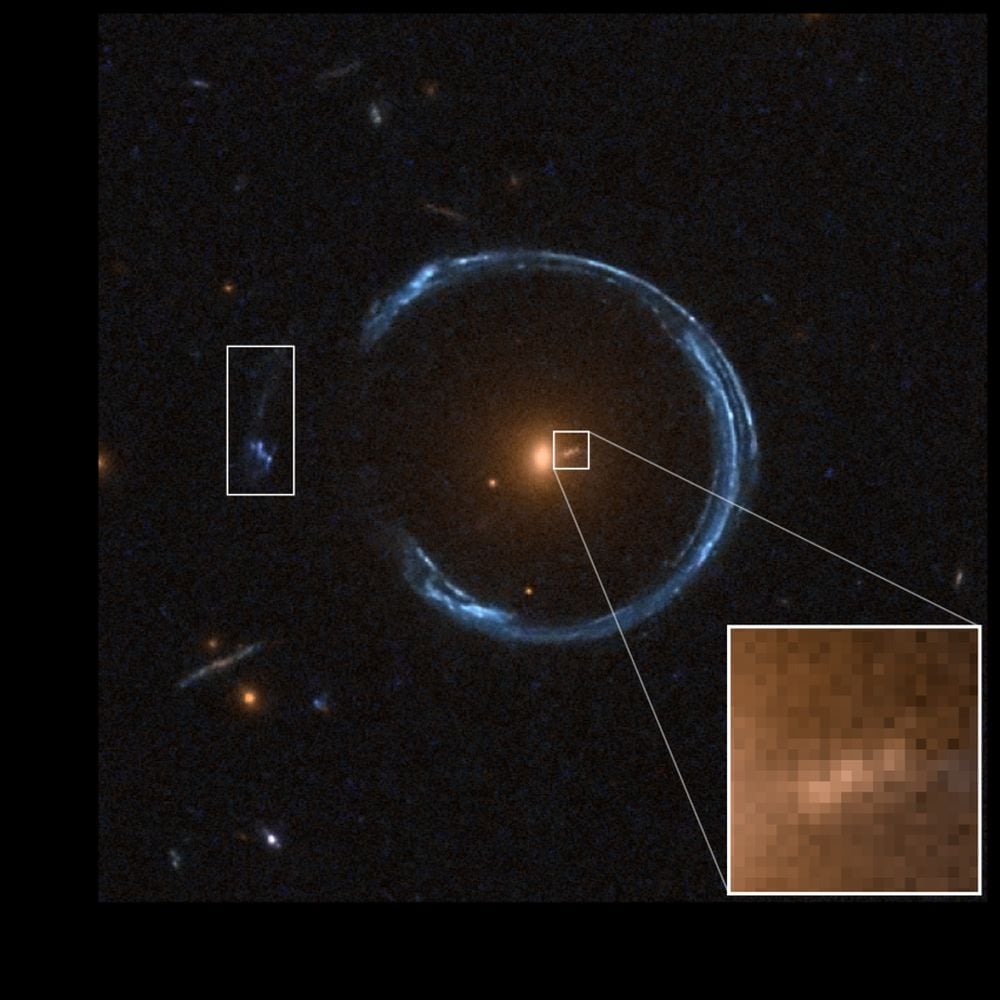 Another image of the Cosmic Horseshoe, but with the pair of images of a second background source highlighted. The faint central image forms close to the black hole, which is what made the new discovery possible. Image Credit: NASA/ESA/Tian Li(University of Portsmouth). Licence type: Attribution (CC BY 4.0)
Another image of the Cosmic Horseshoe, but with the pair of images of a second background source highlighted. The faint central image forms close to the black hole, which is what made the new discovery possible. Image Credit: NASA/ESA/Tian Li(University of Portsmouth). Licence type: Attribution (CC BY 4.0)
SMBH’s are more easily detected when they’re actively accreting material and emitting powerful radiation as active galactic nuclei, the brightest of which are called quasars. AGN and quasars emit their radiation across the spectrum, especially in x-rays, and this makes them visible from great distances. But when they’re dormant, they’re extremely difficult to detect. Thanks to the Cosmic Horseshoe gravitational lens, this dormant black hole is visible.
Lead author Melo said, “This discovery was made for a ‘dormant’ black hole – one that isn’t actively accreting material at the time of observation. Its detection relied purely on its immense gravitational pull and the effect it has on its surroundings.”
Beyond just detecting the black hole, they were able to measure its mass.
“What is particularly exciting is that this method allows us to detect and measure the mass of these hidden ultramassive black holes across the universe, even when they are completely silent,” said Melo.
When distant black holes are active galactic nuclei, astrophysicists have something to work with. The properties of their emissions allows scientists to estimate their accretion rates, which leads to estimating their masses. That method is uncertain, which is why there’s uncertainty around which SMBH is the most massive, while at the same time a top ten list is relevant.
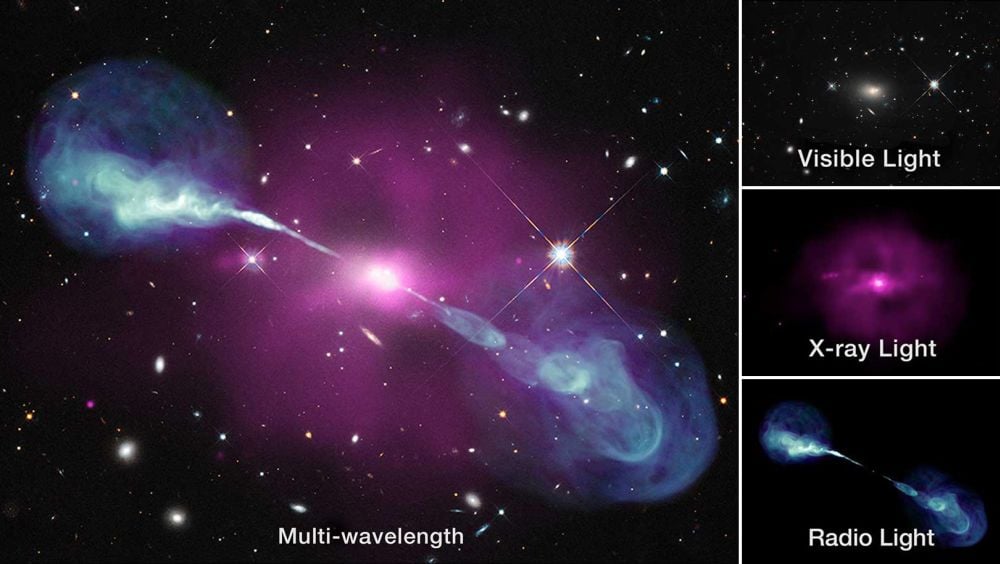 These are images of Hercules A, an AGN over two billion light-years away. It emits light across the electromagnetic spectrum, especially in x-rays. Image Credit: X-ray: NASA/CXC/SAO; visual: NASA/STScI; radio: NSF/NRAO/VLA.
These are images of Hercules A, an AGN over two billion light-years away. It emits light across the electromagnetic spectrum, especially in x-rays. Image Credit: X-ray: NASA/CXC/SAO; visual: NASA/STScI; radio: NSF/NRAO/VLA.
“Typically, for such remote systems, black hole mass measurements are only possible when the black hole is active,” Melo said. “But those accretion-based estimates often come with significant uncertainties. Our approach, combining strong lensing with stellar dynamics, offers a more direct and robust measurement, even for these distant systems.”
Astrophysicists are almost certain that the mass of a galaxy and the mass of its SMBH are linked. It would be a huge surprise if they aren’t.
“We think the size of both is intimately linked,” Professor Collett added, “because when galaxies grow they can funnel matter down onto the central black hole. Some of this matter grows the black hole but lots of it shines away in an incredibly bright source called a quasar. These quasars dump huge amounts of energy into their host galaxies, which stops gas clouds condensing into new stars.”
There’s a strong correlation between a SMBH’s or UMBH’s mass and the stellar velocity dispersion in the galaxy’s central bulge. The most massive black holes are found in galaxies where these stars faster, which makes intuitive sense. There’s also a relationship between the black hole’s mass and the combined mass of the stellar bulge. These relationships suggest that black hole and galaxy evolution are linked.
However, the Cosmic Horseshoe black hole seems to be more massive than it should be, according to the galaxy’s stellar velocity dispersion. The authors say that it’s an outlier, and that it appears “overly massive for the host galaxy’s effective velocity dispersion.” It’s not the only one, and “This deviation at the massive end likely reflects distinct evolutionary pathways during the formation and assembly of these galaxies,” they write.
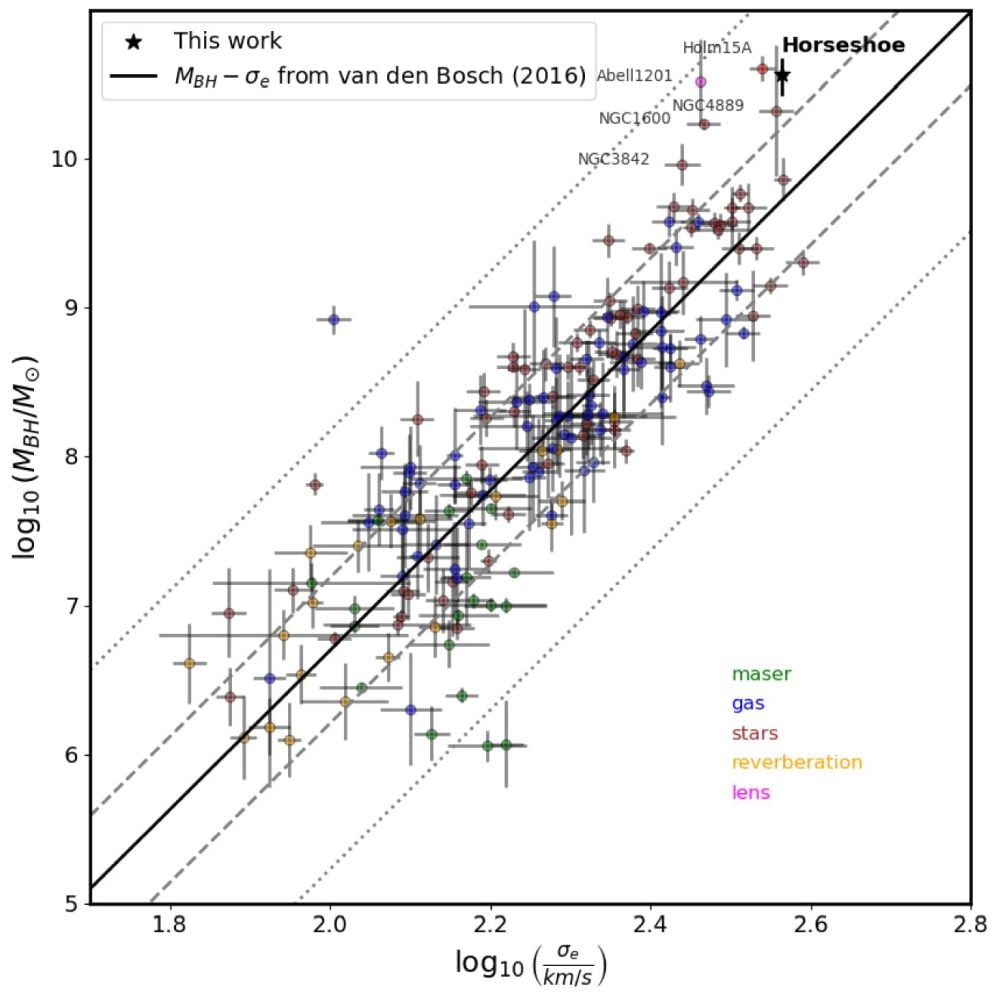 This figure illustrates the relationship between black hole mass and galaxy mass. The solid black line is the relationship established by previous researchers, while the dashed and dotted lines represent 1 sigma and 3 sigma scattering respectively. The UMBH at the centre of the Cosmic Horseshoe’s main lens is marked by a star. Other UMBHs that deviate significantly from the relation are also shown. Image Credit: Melo et al. 2025. MNRAS.
This figure illustrates the relationship between black hole mass and galaxy mass. The solid black line is the relationship established by previous researchers, while the dashed and dotted lines represent 1 sigma and 3 sigma scattering respectively. The UMBH at the centre of the Cosmic Horseshoe’s main lens is marked by a star. Other UMBHs that deviate significantly from the relation are also shown. Image Credit: Melo et al. 2025. MNRAS.
The UMBH’s mass suggest that it’s part of a fossil group of galaxies. Fossil groups begin with several large galaxies. Over billions of years, the most massive galaxy in the group begins to dominate the others gravitationally. It eventually captures and merges with the others, leaving one massive galaxy.
The authors write that the UMBH’s mass represents “a unique evolutionary history for the Cosmic Horseshoe, which is likely part of a fossil group” that we’re seeing as it existed about 4.8 billion years ago. “The central galaxies of fossil groups, as remnants of early galaxy mergers, may follow distinct evolutionary pathways compared to local galaxies, potentially explaining the high SMBH mass.”
“It is likely that all of the supermassive black holes that were originally in the companion galaxies have also now merged to form the ultramassive black hole that we have detected,” said Professor Collett. “So we’re seeing the end state of galaxy formation and the end state of black hole formation.”
This level of analysis was only possible because of the Cosmic Horseshow and its near-complete circle, which the researchers call a radial arc. Future telescopes will find more of them, hopefully leading to a better understanding of UMBHs and the galaxies they reside in.
“Radial arcs, like the one studied here, are expected to become increasingly common. The Euclid mission is expected to discover hundreds of thousands of lenses over the next 5 yr, while the Extremely Large Telescope will revolutionize our ability to conduct detailed dynamical studies,” the researchers explain in their paper.
“The combination of lensing and dynamics will soon provide an unprecedented sample of galaxies, offering exciting insights into stellar populations, DM haloes, and SMBHs across a broader redshift range than ever before,” the authors conclude.
